On Friday, the Hume Center for Writing and Speaking hosted “In Conversation with the Inaugural Poem: Shaping the Future with Language,” which featured the written and spoken work of six Stanford students who responded to Amanda Gorman’s inaugural poem, “The Hill We Climb.”
Adam Banks, the faculty director for the Program in Writing and Rhetoric and the Institute for Diversity in the Arts, opened the event by offering his own analysis of the poem that, since its delivery, has continued to capture the attention of millions across the United States.
“[Gorman’s poem] gave us space to tell our truths individually and collectively, to reckon with the depths and details of our past, and allow us to imagine and build and work for futures that are more just, that are more human,” Banks said.
Stanford president Marc Tessier-Lavigne also helped open the event by sharing a passage from “The Hill We Climb.” Tessier-Lavigne said he was “astonished by the extraordinary poem and [Gorman’s] even more extraordinary delivery.”
The six responses to the inaugural poem were presented in pairs by Zandra Jordan, the director of the Hume Center for Writing and Speaking at Stanford University.
The first pair of poems focused on the history of the United States and how that history continues to shape the society we live in today. Jed Ngalande ’23, who is also a writer for The Daily, presented his poem “Kill the Past to Become It; Keep the Past to Build ‘Bove It.” The poem examines the role of U.S. presidents in shaping the culture of the nation as well as the changing role of the Constitution from the time of its creation to modern day America. Ngalande wrote that while some think the history of the United States should not be rehashed, “if we erase our foundations, we will stumble and fall as if over a latchet.”
“A Country More Beautiful” by Courtney Rosales ’23 also explores the changing nature of our society throughout history, with emphasis on the very different realities people in the United States face every day. Rosales wrote that when America looks at itself in a shattered mirror, “one sees freedom, while one sees confinement.” This theme of different Americas was woven throughout the poem, and the country must “gaze upon its reflection,” in order to become “A Country More Beautiful.”
Further building on the theme of inequity in our society, Temiloluwa Adeyemo ’23 shared a poem about racial violence, and Estefania Acuna ’23 presented a slide deck of images from 2020. Adeyemo’s poem recounts the countless Black lives lost throughout our nation’s history, with focus on Emmett Till, Trayvon Martin, Aiyana Mo’Nay Jones, Ahmaud Arbery, Breonna Taylor and George Floyd. He wrote: “Don’t think these are all the lives we’ve lost, sitting back, I reminisce gaining strength to fight for their cause.” The poem ends with a call to action, as Adeyemo told listeners to donate and fundraise and that “using your voice is not a choice.”
Acuna’s slide deck of images is centered on events from 2020 that showed both how unequal our society remains, but also that hundreds of thousands of individuals came together to protest this inequality. Gorman’s words inspired Acuna to include images demonstrating the solidarity of first responders, individuals gathering outside the Supreme Court to mourn Ruth Bader Ginsburg’s death and scenes from Black Lives Matter protests across the country.
“Amanda Gorman reminded us of the fragility of American democracy and the pitfalls of our country,” Acuna said. “But at the same time, she invited us to rise above the rubble of our differences. And hope for a brighter future.”
Stacey Coleen Lubag ’24 also focuses on the future of both her personal life and the country in her poem “Time.” Lubag reflects on her own journey to Stanford and how she rose above people who doubted her as well as her fears about the cost of attending college. She contrasts her own journey over the past four years with the journey of the United States under Trump’s presidency, writing that it was a force that “did its best to rip our nation’s heart at the seams.”
Tiffany Saade ’24, who also writes for The Daily, examined the interplay between the daily light in our lives that guides us forward in a video called “The Light.” The video, almost five minutes long, follows Saade on a bike ride through the Stanford campus as she passes by many well-known landmarks on campus, including Memorial Church and Palm Drive. Saade reflects on the light in our lives being scary, yet comforting, while also unpredictable.
“It is dusty and imperfect, as it sprinkles into your life. All of a sudden, you find it in a place you never thought it could be found,” Saade said.
Taken together, the six student pieces presented at the event encouraged the audience to face our nation’s imperfections while also continuing to search for the bright spots in our democracy that can help the country heal and continue evolving to be more just and inclusive.
Jordan also encouraged the audience to consider their responses to the event.
“We want to think about how we can be a part of the transformation and the change that needs to happen in our world. It starts with us. So think about what you’re willing to do so that we can all be free,” Jordan said.
This article has been corrected to reflect the correct spelling of Aiyana Mo’Nay Jones’ name. The Daily regrets this error.
